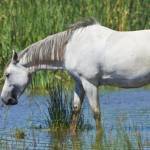Avoid Water Problems in Your Horse Barn

Every horse enthusiast has visited farms where winter rain and snow have turned the barn floor into a swamp. This problem is not uncommon if barns have been built in unsuitable places or if heavy traffic in and out of the barn has changed the soil contour of the doorways and aisles. If you have acquired new property and are planning to build a barn, how can you avoid this soggy scenario?
Try to avoid ever having drainage problems by choosing the best site for your barn. For superior drainage, the barn should be built on high ground. If this isn’t possible, the ground should be artificially contoured so that the flat barn site is surrounded by land that slopes slightly away from it. This contouring can be done on a gently sloping hillside unless the soil depth to rock is minimal.
Install gutters and downspouts or construct shallow ditches at the sides of the barn to direct water away from the structure. These ditches can be filled with crushed rock, perforated pipe, or tile drains. It is well worth the cost to consult with a drainage engineer who will know the best way to construct drains that will handle the anticipated volume of water while avoiding silt and vegetation that will clog the channel.
All that water has to go somewhere, and it’s best to try to keep the drainage out of pastures and paddocks to avoid developing muddy areas. Run-off can be channeled to grassy areas between paddocks. Trees and bushes planted in these areas will help to take up water, slowing the flow and preserving topsoil.








